745 WONDERING ABOUT WHEATENS
WONDERING ABOUT WHEATENS
by David Hancock
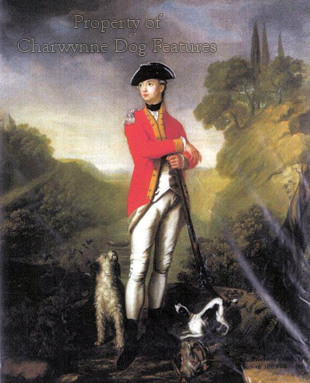 The wheaten hue is a common terrier colouration, being found in the Border, Lakeland, Norfolk, Norwich, Cairn and Scottish Terrier breeds, as well as the terriers from Ireland. I have never liked the title of the Irish breed: Soft-coated Wheaten Terrier; no breed should be identified just by the texture or colour of its coat and there are plenty of wheaten terriers. Such a distinctive and admirable breed deserves a much more precise breed title. In his foreword to Maureen Holmes’s book The Wheaten Years, of 1977, Henry Fottrell, then chairman of the Irish Kennel Club, wrote: “They were generally called Irish Terriers. That is why there was opposition for some years by the Irish Terrier representative on the Irish Kennel Club to their recognition as a distinct breed. It was only when it was suggested that they be officially called Soft-coated Wheaten Terriers that opposition was overcome and a breed register opened.” I wonder sometimes if those involved in the pedigree dog world truly understand how breeds evolved, led by function.
The wheaten hue is a common terrier colouration, being found in the Border, Lakeland, Norfolk, Norwich, Cairn and Scottish Terrier breeds, as well as the terriers from Ireland. I have never liked the title of the Irish breed: Soft-coated Wheaten Terrier; no breed should be identified just by the texture or colour of its coat and there are plenty of wheaten terriers. Such a distinctive and admirable breed deserves a much more precise breed title. In his foreword to Maureen Holmes’s book The Wheaten Years, of 1977, Henry Fottrell, then chairman of the Irish Kennel Club, wrote: “They were generally called Irish Terriers. That is why there was opposition for some years by the Irish Terrier representative on the Irish Kennel Club to their recognition as a distinct breed. It was only when it was suggested that they be officially called Soft-coated Wheaten Terriers that opposition was overcome and a breed register opened.” I wonder sometimes if those involved in the pedigree dog world truly understand how breeds evolved, led by function. 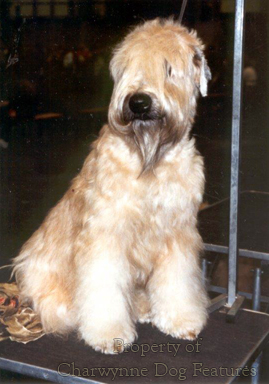
In her book, Maureen Holmes wrote: “The breed has always been in its native country, Ireland, and can be traced for close on 200 years. It is true there is no specific mention of it in records or writings…most carry references to Irish Terriers and the colour wheaten; open coated is a description that occurs from time to time. Kerry Blues are not mentioned as such either in any old records. The generic term Irish Terriers covered all the terriers of Ireland; it is a collective term and does not mean Irish Terriers, the distinctive breed so well known today.” This is not unusual; there are no specific historical references to the English Deerhound, the smooth-coated par force hound usually being termed a greyhound. Similarly, the word bulldog referred to a role not the breed with that title today. Maureen Holmes goes on to state: “How could Soft-coated Wheaten Terriers be specifically mentioned as such when they had no official name until 1937?” Such a dilemma faces so many breed historians. Two hundred years ago a litter of terrier pups in Ireland could contain coat colours ranging from black and grey, red and tan to silver and gold, wheaten and white.
When I was working in County Down some forty years ago, I used to see what could be called straw-coloured terriers on farms there, really like coarsely-bred wheatens. A while later I came across a painting of John Rawden-Hastings, son of the Earl of Moira, attributed to Robert Fagin, who died in 1812. In this painting there are two terriers, one remarkably like the rough-coated straw-coloured terriers I saw in County Down. The Earls of Moira had property in County Down and I wondered immediately if this portrayal was of an early wheaten terrier. In her book The Dogs of Ireland, Dundalgan Press 1981, Anna Redlich writes: “Wheaten Terriers have been kept for generations on the farms of this country where they have been used for cattle work, for pursuing and destroying vermin, and, like their next-of-kin the Kerry Blue and Irish Terrier, have enjoyed a day’s shooting in the company of their master.” So often we think of breeds solely in specialised roles and forget the all-round use of dogs in rural areas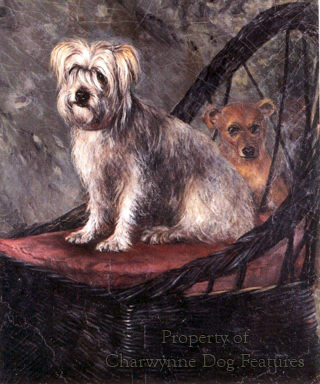 .
.
When working in Ireland it was always of interest to study the farm dogs there; so many of them, ungroomed and unclipped, resembled the bouviers of Belgium, the Dutch Terrier or Smoushond and the stable dogs of Germany, the schnauzers. Going to work in Germany, immediately after working in Ireland, allowed me to keep a picture of Irish farm dogs in my mind when viewing their equivalents on mainland Europe. I have seen both schnauzers and wheaten terriers being used as herding dogs in their native countries and appearing interchangeable in form and technique. Once, at a world dog show I was convinced that the Bouvier des Flandres before me was a large Soft-coated Wheaten Terrier from Ireland. Size apart, the appearance, the coat, the personality and the attitude were easily confused. I see similarities too between the Kerry Blue and the Laekenois of Belgium and the Schnauzer; perhaps the farm function deciding form.
That great chronicler Rawdon Lee, in his volume on terriers in his Modern Dogs series of 1896, writes, quoting a Mr WC Bennett of Dublin: “I have several times been assured, by those from whom I sought information, that a special strain of Irish terriers was kept in their families for generations, and they usually described them as wheaten coloured, open-coated, with long, punishing jaws, and I was shown…a game-looking wheaten coloured bitch, long and low on the leg, with a very open coat, long, level head, with little or no stop visible. The owner claimed to have had her breed for over thirty years in his family. I can vouch that she would fight until nearly killed, if once provoked.” This might have been a Glen of Imaal, but terriers in Ireland were usually interbred on merit not confined to distinct breeds.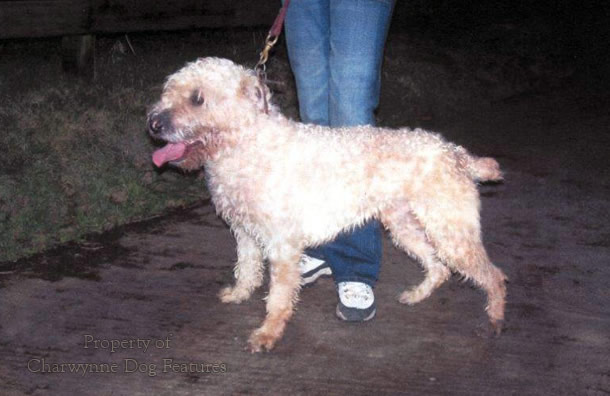
Anna Redlich also writes in her book on the dogs of Ireland: “Wheaten Terriers, used for centuries to hunt the otter and the badger in their native soil, invariably came out first when entered in any Field Trial held by the Working Terrier Association of Ireland. Wheatens scored top honours at the Championship Hunting Competitions of September, 1937, 1938 and 1939. At the Field Trials in June, 1938, two of these terriers qualified for the Certificate of Merit, an honour which none of the other competing terriers were able to attain. Placed first at many of the Badger Trials of the Association, the breed, since it was allowed to compete, has in fact won more certificates at these Trials than all strong terriers put together and has therefore proved the pre-eminence of the Wheaten as a sporting terrier.” The sporting heritage of this breed is impressive; I only hope the current fad, especially in North America for over-coated specimens doesn’t handicap such game dogs too much.
In 2006, a championship show breed judge reported: “Upright shoulders, loose elbows and hence poor front movement were prevalent, particularly in the (male) dogs…” I do hope they were not bred from; these are appalling faults in a sporting terrier. Six years earlier the Crufts judge for the breed remarked “…we really do need to consider our breeding programmes very carefully.” Were these words heeded? Sadly, most judges are more concerned with coat than soundness, not a good sign. 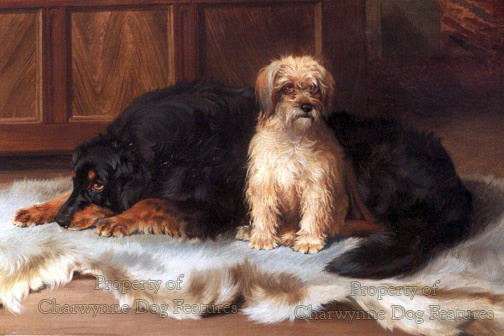
I like the look of the working Wheatens bred by Declan Looney of Belfast: workmanlike, not over-coated and with a real glint in their eye. There are working Wheatens in Wales that do not feature the heavier coat of the show ring Soft-coated Irish Wheatens. The wheatens that are depicted in old paintings of dogs, like William Trood’s Waiting for Master of 1891, show a golden-coated, but not over-coated, much more functional dog. In the 2004 breed health survey for Soft-coated Wheatens the most common conditions reported were in the dermatological category at 14.1% with dermatitis, sebaceous cysts, pyotraumatic dermatitis or hot spots and fading nose pigment listed. 13% reported ear problems, way above the average for other breeds. These are all conditions that can be linked to excessively coated jackets. Our sporting ancestors, in developing such terriers for us, never sought or tolerated excessive coats in their dogs and we are learning to respect their judgement. Such a distinctive and wholly admirable breed as the Soft-coated Wheaten deserves our very best custodianship and this includes putting their best interests way ahead of our contemporary fad for heavy coats - and grooming orgies! If this is to remain a sporting terrier breed then its fanciers have to put aside show ring preferences and respect the breed’s origin a great deal more.